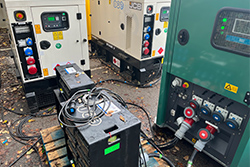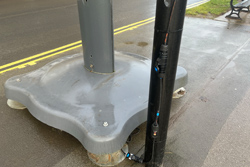 Find out how we helped to make massive power savings for the 2023 event
Find out how we helped to make massive power savings for the 2023 event
IPS are proud to have provided a range of services for the Lumiere event, which took place in Durham during November. Working for event organiser Artichoke, we provided Staging & Structures, Power as well as supplying sound and lighting equipment to support some of the 39 different light art installations that made up the event. Just under 13,000 items were dispatched from the IPS warehouse for this project, including over 10km of power cabling, connected via more than 100 IPS mains distribution units. Check out our social media pages for photos of some of the structures we were involved with on facebook here or linked in here.
Power generation, distribution and cabling was a major logistical consideration with this project, as many of the light art installations were interweaved within the historic city of Durham – not to mention the wind and wet conditions in a UK autumn/winter outdoor project! One of the requirements for the power supply was for sustainable options to be provided at every opportunity. This is an area where IPS project manager Andy Murray excelled, using a host of different innovative solutions to replace or minimise fuel usage. This also represents the biggest number of battery powered installations on an IPS project to date. In total, over 1000 hours of generator runtime was saved compared to previous years installations.
With the goal of reducing overall power consumption as well as local exhaust emissions, existing mains supplies were sought first, and where they were not available or not suitable, they were either supplemented or replaced with other means. All generators used onsite used HVO fuel rather than diesel, and the latest low emission stage V sets were used wherever possible. Remote telemetry enables many units to be monitored remotely which gives a good picture of system performance and helps with fuel management planning.
Working closely with artists and suppliers to calculate estimated power requirements was a key part of the process - helping to match the supply and demand for electrical supply is a fundamental part of operating efficiently. One the specific requirements and site location have been identified; we can then work out the most appropriate solution. For Lumiere 2023, an array of clever solutions were deployed around the site – read on if you’d like to know the more technical details:
 Local Mains Power Supplies – Connecting to local power supplies sounds simple as a plan. Coordinating with all relevant stakeholders, as well as testing to verify supplies, electrical protection and earthing arrangements as well as establishing cable routes make this is a lot more complicated in practice – but well worthwhile where possible. Lots of IPS inline RCD protection units were used, and our highly qualified team used a full range of techniques, connecting into all kinds of supplies from domestic and commercial premises to street lighting to make use of all available supplies.
Local Mains Power Supplies – Connecting to local power supplies sounds simple as a plan. Coordinating with all relevant stakeholders, as well as testing to verify supplies, electrical protection and earthing arrangements as well as establishing cable routes make this is a lot more complicated in practice – but well worthwhile where possible. Lots of IPS inline RCD protection units were used, and our highly qualified team used a full range of techniques, connecting into all kinds of supplies from domestic and commercial premises to street lighting to make use of all available supplies.
Mains supply with Battery for additional show capacity – One installation location had an existing supply in place, but the artist requirements needed more power to run the show. We deployed a substantial 120 kWh battery unit which with a clever switchgear configuration to enable the battery unit to charge during the day, and then operate to supplement the existing mains supply during the show to deliver the full power requirement. The silent running of the battery unit in operation also made locating the set much easier in the sensitive historical location.
Stand Alone Battery Power – Making full use of our compact instagrid battery packs, for a remote location with a lower power requirement, we charged the battery during the day at the site compound, and then fitted it each night for show in the installation location for a completely standalone battery operation. A further installation which had an available local mains supply but was fitted with a large battery unit that powered the show, and then recharged with the mains supply during the day. The high-capacity battery was able to deliver a higher peak load than the installed supply could sustain, and then the charge period between shows enabled the set to charge from the mains – meaning that although the power all still ultimately came from the same source, the battery acted like a big capacitor, and the show was effectively self-contained during the operation.
Battery as UPS – Another perfect application for our instagrid battery packs was for a mission critical link where the battery was configured like an uninterruptable power supply. A CCTV position and key link in a wireless network bridge for this event was in a particularly remote location (in terms of available power supplies). Whilst the power demand was minimal, this infrastructure link was essential and couldn’t have any downtime – so a UPS was a logical requirement. The location was able to be powered from the end of an almost 1km cable run which provided power during the show and charging for instagrid battery pack which was configured to act as a backup UPS during showtime, and then take over and provide daytime power outside of show running hours.
 Generator for Event Power with Battery for backup and mains supply for overnight – A bit of everything on this installation just to test our technicians! One of the more complicated set ups, this configuration required a higher capacity supply than could be delivered from the available mains, so a single generator set was deployed with a large capacity battery as a back up unit. The battery also provided the standby power, providing a buffer between supplies to ensure a continuous power source was provided to the projectors and control equipment, and charging from the mains supply where needed. This configuration made the most use of the available power supply and minimised the generator usage with the support of the battery capacity.
Generator for Event Power with Battery for backup and mains supply for overnight – A bit of everything on this installation just to test our technicians! One of the more complicated set ups, this configuration required a higher capacity supply than could be delivered from the available mains, so a single generator set was deployed with a large capacity battery as a back up unit. The battery also provided the standby power, providing a buffer between supplies to ensure a continuous power source was provided to the projectors and control equipment, and charging from the mains supply where needed. This configuration made the most use of the available power supply and minimised the generator usage with the support of the battery capacity.
Generator for Event Power with Battery for Standby – This was one of our most deployed solutions around the site. This configuration allows for the higher show power demands to be met by the conventional generator, and then lower power requirements outside of show times to be met with a battery. Equipment is often left on between shows to maintain settings and ensure equipment doesn’t get too cold but has a significantly lower power requirement which can be met by a battery. The batteries can charge either during showtime if there is spare generation capacity, or the generator can come back online during the day to boost levels as required. Both generator and battery capacity can be varied to match the application, and various configurations were in use from with batteries from 10kWh to 96kWh in use supported by generators from 20kVA to 200kVA.
Redundant Load Share Generators with overnight/low load battery backup – Similar to the above configuration, but for areas which had a higher residual power requirement compared to the show/standby requirements a higher capacity solution was needed. For these applications, we deployed a synchronised pair of generators to enable load sharing for high demand as well as some supply redundancy, as well as a battery unit to enable the system to scale right down and become zero emission when demand dropped. As with the other setup, the battery charged either on demand after becoming depleted, or when excess power was being generated. This scalable setup helps reduce emissions as well as minimize fuel usage.
Generator only – There were some applications where an existing supply or battery solution wasn’t workable. This was either due to the output capacity or the sheer weight and size of the larger battery sets being prohibitive. For these applications, careful matching of generator output to load demand meant that the installation could still be delivered in the most fuel and cost-effective method whilst also minimizing emissions. The constant developments in both battery and generation technologies mean that the crossover point for these applications is always changing, so something that will always be kept under review for future projects.
 The stats and figures from this event show there has been a significant saving in terms both of fuel used onsite and emissions from the event compared to previous years. The IPS team provided power services and equipment which included 10 different battery packs and 12 Generator units, plus a variety of spares. Thousands of metres of power cabling, a wide range of power distribution units and various timers, switches and sensors were also deployed onsite. All systems were commissioned and tested to the relevant standards – and then as with all temporary events, everything was removed again without leaving a trace.
The stats and figures from this event show there has been a significant saving in terms both of fuel used onsite and emissions from the event compared to previous years. The IPS team provided power services and equipment which included 10 different battery packs and 12 Generator units, plus a variety of spares. Thousands of metres of power cabling, a wide range of power distribution units and various timers, switches and sensors were also deployed onsite. All systems were commissioned and tested to the relevant standards – and then as with all temporary events, everything was removed again without leaving a trace.
Overall, a lot of detailed calculations and planning, some clever load sharing and a very clever team of onsite power technicians (big shout out to Ham, Nick, Cyrus, Will & Shaun for all their hard work onsite) enabled this impressive array of solutions to be delivered. If you have an event coming up, and you would like to rethink the power plans, the more detailed the load and running time information and the earlier this is integrated into the planning process, the better the outcome. IPS have an extensive range of power generation, distribution, cabling and cable management solutions- and much more besides. Lots of equipment is ready to hire now, and you can see the options on our website, or get in touch to discuss a full power solution.













